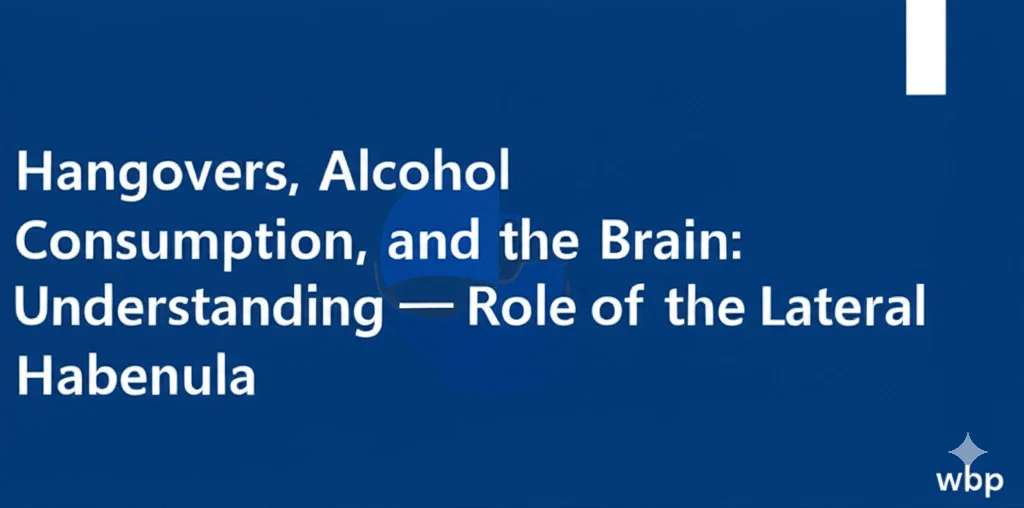Hangovers, Alcohol Consumption, and the Brain
Understanding the Role of the Lateral Habenula

Research has identified the lateral habenula as a key brain region regulating alcohol consumption by linking negative effects, such as hangovers, to overdrinking. This region helps balance the brain’s reward system, discouraging excessive alcohol use by associating short-term pleasure with long-term harm. When impaired, the lateral habenula fails to moderate drinking behaviour, potentially contributing to alcohol dependence. These insights suggest new therapeutic opportunities, such as treatments targeting the lateral habenula to enhance its function, offering more effective interventions for alcohol use disorders, particularly for those with a genetic predisposition to addiction.
The Lateral Habenula and Alcohol Consumption
The lateral habenula is responsible for processing the brain’s reward-and-punishment mechanisms, which play a significant role in controlling alcohol consumption. This area of the brain helps individuals learn from the negative experiences that arise from drinking, such as hangovers and other unpleasant side effects.
In a study involving rats, scientists found that when the lateral habenula was impaired, the affected rats drank more alcohol over time, despite the negative consequences typically associated with excessive drinking. Conversely, rats with normal brain function reduced their alcohol intake due to the discomfort caused by hangovers and intoxication. This suggests that the lateral habenula influences how individuals adjust their drinking behaviour in response to the negative effects of alcohol.

Reward vs. Adverse Effects of Alcohol
The balance between the pleasurable effects of alcohol and the adverse consequences of drinking is critical in determining consumption patterns. According to researchers, the lateral habenula plays a pivotal role in this balancing act. When this part of the brain is functioning normally, it allows the unpleasant effects of alcohol, such as sickness and hangover, to outweigh its rewarding sensations. However, when the lateral habenula is inactive or impaired, the brain favours the pleasurable effects, leading to increased alcohol consumption despite negative experiences.
This was further demonstrated in an experiment where rats were given a sweet juice, followed by an injection of alcohol to induce hangover symptoms. While the control rats associated the juice with sickness and subsequently avoided it, the rats with an impaired lateral habenula continued to consume the juice, showing that they did not link the negative effects to the alcohol.
These findings suggest that the lateral habenula could be key in explaining why some people can naturally moderate their drinking, while others struggle. An impaired or underactive lateral habenula may reduce sensitivity to the negative effects of alcohol, making it harder for individuals to cut back despite experiencing hangovers or other consequences. This could help explain some cases of alcohol use disorders, where individuals are less able to learn from negative drinking experiences.
Implications for Human Behaviour and Alcoholism
The findings from these experiments may have profound implications for human behaviour and the development of alcohol use disorders. The research suggests that the lateral habenula might play a crucial role in encouraging abstinence after negative drinking experiences, such as hangovers. If this part of the brain is impaired or naturally underactive, it may prevent individuals from learning from the unpleasant consequences of alcohol, potentially leading to increased consumption and a higher risk of developing alcoholism.
The possibility that a low-functioning lateral habenula could predispose individuals to alcohol dependence raises important questions about biological susceptibility to addiction. This research opens new pathways for understanding how brain function affects drinking behaviour and how it might contribute to substance use disorders. Furthermore, these insights could eventually inform better strategies for the diagnosis, treatment, and prevention of alcohol-related issues, recognising that some individuals may be more vulnerable due to factors beyond their control.
Implications for Alcoholism Treatment
The role of the lateral habenula offers new avenues for treating alcohol use disorders. If the brain’s ability to regulate alcohol consumption is compromised, treatments targeting this region could help individuals regain control over their drinking. This could lead to more personalised therapies, particularly for those who may be biologically predisposed to excessive drinking or addiction. Understanding this brain function could support more effective interventions, addressing the neurological aspects of alcohol dependence.
Future therapies might include medications that enhance the lateral habenula’s ability to process negative feedback from drinking, helping people reduce alcohol intake. Such treatments could be especially helpful for those with a biological predisposition to alcohol dependence, offering a more targeted approach to managing addiction.
Understanding the lateral habenula could also allow for earlier intervention. If assessments can identify individuals with an impaired lateral habenula, preventive strategies could be introduced before problematic drinking starts, reducing the risk of alcohol dependence in those more vulnerable to addiction.
Research conducted by Adam Spies from Rehab Johannesburg and sources include AlcoholAddiction.co.za help and AddictionRehab.co.za in South Africa.
The Lateral Habenula’s Role in Alcohol Consumption and Addiction
The lateral habenula plays a critical role in how the brain regulates alcohol consumption by linking negative experiences, such as hangovers, with the decision to moderate drinking. When functioning properly, it helps balance the rewarding effects of alcohol against the unpleasant aftereffects, discouraging further consumption. If this brain region is impaired, individuals may struggle to make this connection, leading to excessive drinking despite negative consequences. This could explain why some people continue to drink heavily even when experiencing repeated hangovers.
Interestingly, there may be a genetic component to the function of the lateral habenula, meaning that some individuals could be biologically predisposed to alcohol dependence. Those with a naturally underactive lateral habenula may not effectively learn from the adverse effects of alcohol, making them more vulnerable to addiction. This shifts our understanding of alcohol use disorders from being solely behavioural or environmental to including a biological factor. It also opens the door to personalised treatments that target this brain function, such as medications designed to enhance the brain’s ability to process the negative feedback associated with alcohol consumption.
The lateral habenula’s role may extend beyond alcohol to other forms of addiction, such as drug use or gambling, suggesting that treatments targeting this brain region could help address multiple types of substance use disorders. Furthermore, early intervention could become a possibility if brain assessments can identify individuals with impaired lateral habenula function before their drinking becomes problematic. This could help prevent the development of alcohol dependence, particularly in those who are genetically or biologically predisposed. Advances in brain imaging and neurofeedback therapies could further support these efforts, offering a more comprehensive approach to managing alcohol-related behaviours by addressing the brain’s role in decision-making and impulse control.

The Lateral Habenula’s Role in Alcohol Consumption and Dependence
The lateral habenula, a small but crucial part of the brain, regulates alcohol consumption by helping the brain link negative experiences, like hangovers, with drinking behaviour. It plays a key role in balancing the immediate pleasurable effects of alcohol with the long-term negative consequences. When this brain region functions properly, it discourages excessive drinking by reinforcing the connection between overconsumption and unpleasant outcomes. However, when the lateral habenula is impaired, people may fail to recognise or act on these negative consequences, leading to increased alcohol use. Animal studies have shown that when this brain area is damaged, subjects continue to drink even when it makes them sick. In humans, this dysfunction could explain why some individuals persist in heavy drinking despite experiencing repeated hangovers or negative health effects.
The lateral habenula is also closely tied to the brain’s reward system, specifically, dopamine regulation. Alcohol boosts dopamine release, producing feelings of euphoria. Normally, the lateral habenula helps suppress this over-rewarding response, keeping the brain’s reward system in balance. But when this regulation breaks down, the brain seeks the pleasure of alcohol, ignoring the harm it causes. Chronic alcohol use can further damage this regulatory mechanism, leading to compulsive drinking and alcohol dependence.
Genetic Vulnerability and Treatment Possibilities
Research suggests that genetic factors may influence the activity of the lateral habenula. Some people may have a naturally less active lateral habenula, making them more vulnerable to alcohol dependence. These individuals might not feel the negative effects of alcohol as strongly, which makes it harder for them to moderate their drinking. Understanding this biological predisposition opens new doors for more effective treatments, targeting the brain directly rather than relying only on behavioural interventions.
New therapies could focus on restoring or improving the lateral habenula’s ability to process negative feedback from alcohol. Medications that enhance its function could help reduce drinking by allowing individuals to better associate alcohol with its adverse effects. Additionally, research into neuroplasticity, how the brain can adapt and change, suggests that retraining the brain through specific therapies could help reverse some of the damage caused by long-term alcohol use. These approaches could lead to more targeted treatments for alcohol dependence, and potentially other addictions, by focusing on the brain’s core reward and punishment systems.





